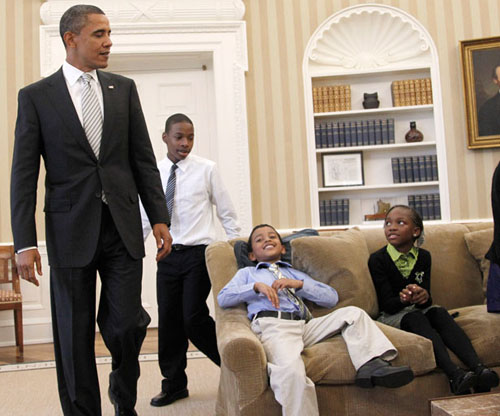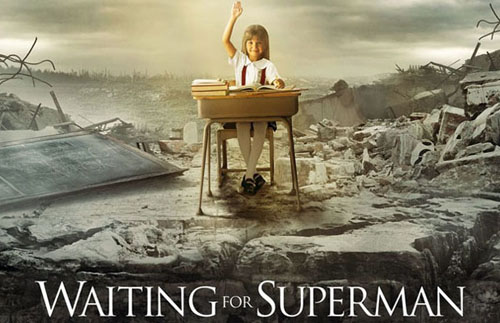Where is the debate? Kenzo Shibata challenges corporate schools reformers on Huffington Post
The phrase "education reform" has been co-opted to mean a narrow party program advocated by the reform establishment (mainly billionaires and their designees) that includes a barrage of testing, charter schools, and taking experienced educators out of the classroom.
 Propaganda for the anti-union film "Waiting for Superman" reached its apogee with the October 11, 2010 White House visit form the Waiting for Superman children, who met with President Barack Obama. Obama's hostility to real public schools and to the teachers' unions began as soon as the Chicago Teachers Union had lifted him into the Democratic Party nomination to the vacant U.S. Senate seat for Illinois in 2004. Support from the CTU (which included providing Obama with office space and phone bank support during his campaign) was the main reason why the Cook County Democratic Party endorsed Obama over Dan Hynes, the machine candidate, at that time. Within three years, Obama was soliciting millions of dollars from anti-union Hedge Fund operators, private school promoters, and billionaires and adopting the union-busting programs that would become "Race to the Top" under Arne Duncan. Since teachers provided key margins in his 2008 election victory, Obama has never provided real public school teachers with the kinds of publicity stunts he helped orchestrate in the above photograph for charter schools and propaganda attacks on the unions like "Waiting for Superman."None of these measures have a track record of success, but the actual facts get obscured by Hollywood films [like "Waiting for Superman"] and connected charter groups. It's hard to get into the conversation when the corporate side of education reform uses the term as a bludgeon against anyone who questions its agenda -- even when the concerns are supported by research.
Propaganda for the anti-union film "Waiting for Superman" reached its apogee with the October 11, 2010 White House visit form the Waiting for Superman children, who met with President Barack Obama. Obama's hostility to real public schools and to the teachers' unions began as soon as the Chicago Teachers Union had lifted him into the Democratic Party nomination to the vacant U.S. Senate seat for Illinois in 2004. Support from the CTU (which included providing Obama with office space and phone bank support during his campaign) was the main reason why the Cook County Democratic Party endorsed Obama over Dan Hynes, the machine candidate, at that time. Within three years, Obama was soliciting millions of dollars from anti-union Hedge Fund operators, private school promoters, and billionaires and adopting the union-busting programs that would become "Race to the Top" under Arne Duncan. Since teachers provided key margins in his 2008 election victory, Obama has never provided real public school teachers with the kinds of publicity stunts he helped orchestrate in the above photograph for charter schools and propaganda attacks on the unions like "Waiting for Superman."None of these measures have a track record of success, but the actual facts get obscured by Hollywood films [like "Waiting for Superman"] and connected charter groups. It's hard to get into the conversation when the corporate side of education reform uses the term as a bludgeon against anyone who questions its agenda -- even when the concerns are supported by research.
If we're all in this together, why can't we debate what reform should look like, roll up our sleeves and fix our schools ŌĆö together? There's a lot of work to be done and we need all hands on deck. This isn't possible unless we can actually have free and open discussion about what schools need. That means that we need to look at all of the challenges involved and tackle them directly. We even need to look at the challenge of poverty, since that seems to be the largest impediment to educational achievement. That's not to say it's a brick wall to success, it's just a crucial factor we must address.
Students in well-funded American schools from high-income families outscore nearly all other countries on standardized tests, yet our aggregate scores are low. Many call this an educational crisis. However, if we are looking at root causes, we cannot overlook the fact that the U.S. has the highest level of child poverty in the industrialized world and children living in poverty are achieving far below their affluent peers.
 The anti-union and anti-public schools film "Waiting for Superman" wound up a box office flop, despite all of the money and hype that promoted it among some "liberal" circles. But the movie received an unprecedented propaganda boost when the President of the United States, Barack Obama, hosted an October 2010 media event at the White House on behalf of the film.Schools do not operate in a vacuum. Poverty has devastating effects on a child's social and emotional development. For our poorest students, just getting to school can be a challenge. Anyone who has studied education or psychology knows the venerated "Maslow's Hierarchy of Needs," which shows the steps towards self-actualization -- the level where students can effectively use their creativity and problem-solving skills. At the lowest level are basic human needs like food, water, and health. We need to do a better job of making sure those needs are met.
The anti-union and anti-public schools film "Waiting for Superman" wound up a box office flop, despite all of the money and hype that promoted it among some "liberal" circles. But the movie received an unprecedented propaganda boost when the President of the United States, Barack Obama, hosted an October 2010 media event at the White House on behalf of the film.Schools do not operate in a vacuum. Poverty has devastating effects on a child's social and emotional development. For our poorest students, just getting to school can be a challenge. Anyone who has studied education or psychology knows the venerated "Maslow's Hierarchy of Needs," which shows the steps towards self-actualization -- the level where students can effectively use their creativity and problem-solving skills. At the lowest level are basic human needs like food, water, and health. We need to do a better job of making sure those needs are met.
There are some reforms we can make within the walls of a school that will ameliorate the effects of poverty including: wraparound services, small class sizes, and school libraries. This is by no means an exhaustive list of reforms we can provide to fix schools, but it's a place to start and all three have a track record of success. None of these reforms are included on the lists of the reform establishment.
For many of our poorest students, the school nurse is the only medical professional they see and in many Chicago Public Schools, nurses are stretched between 2-3 schools. Schools need to hire more social workers, psychologists, and nurses to make sure students are healthy enough to take their learning to the next level.
One country that always comes up when discussing models for education reform is Finland, a nation that boasts some of the highest test scores in the world. It is also a nation where students are provided small class sizes and the child poverty rate is 3.4% compared to the United States' 21.7%.
What does this mean? The most quoted and comprehensive study of class size, The Tennessee Study of Class Size in the Early School Grades showed significant advantage to students who had small class sizes in early grades. These small class sizes showed to be especially beneficial to students attending schools in poor districts.
In Chicago, 164 public schools ŌĆö nearly 1 in 4 elementary schools and 51 high schools do not have school libraries. Library hours are typically one of the first cutbacks in city budgets, leaving many of Chicago's poorest students without access to books. This puts them at a disadvantage as access to books has shown to shrink the "achievement gap."
In a video available by link here, University of Southern California Professor Emeritus Stephen Krashen explains in detail the importance of access to books for students during a December 2011 luncheon with staff at the Chicago Teachers Union.
So what can civic-minded corporations do to help fix our schools?
They can start by paying their taxes, which will fund these reform efforts. That's how they show real concern for the community. If they want to do more, they can look at the model used in McDowell County, West Virginia where a partnership was forged between corporations, foundations, and the teachers union.
The partners who signed on agreed to improve housing, transportation, and jobs in the poverty-stricken county. They know all of these factors contribute to low educational achievement. Instead of pointing fingers like the rest of the reform establishment, they offered a hand.
Follow Kenzo Shibata on Twitter: www.twitter.com/kenzoshibata
[The article above appeared first on Huffington Post and is reprinted here with the permisson of Mr. Shibata and others].

